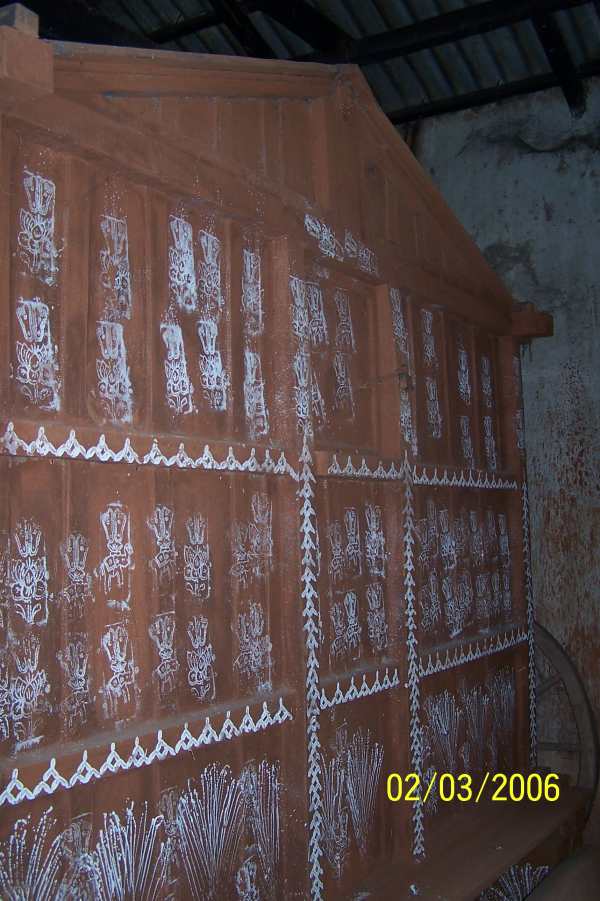Contribute
| South Asian Art History - In Memory Of Prashant H. Fadia |
Sarojini Nayak
11/09/2007
Chitta - Motifs in White The art traditions of rural India continue to fascinate urban dwellers and this is best observed during religious festivals and other celebrations. For instance, no traditional Oriya wedding is complete without the customary drawing of auspicious symbols such as banana plants, a conch shell, a purna kalash(earthern pitcher, with a coconut and mango leaves on top) and the palanquin carrying the bride, all colorfully decorated on the walls. Similarly, chiita (known as alpana in Bengali) is one such rural art,and mainly associated with the Lakhmi puja in Orissa. During the months of November and December, soon afterthe harvest season, housewives celebrate Lakhmi puja to welcome the goddess of wealth. Unlike the Lakhmipuja in North India, where it is celebrated along with Deepavali, the festival of lights, the Lakhsmi puja in Chitta is drawn both on the floors and on mud walls. In rural Orissa, the mud houses are given a fresh coat of paint, using a mixture of mud and cow-dung, and left to dry. Then a paste made of rice powder and water is used to make attractive designs on the walls, using the fingers as the brush. At times, a cotton cloth may be dipped into the paste and used. Another While, motifs of lotus flowers, elephants, birds like parrots and peacocks, and conch shells are the traditional items, at times, new images can also be Similarly, the patterns on the floor are generally round, hexagonal and square designs, with an abundanceof flowers, leaves and creepers. The patterns are drawn at the entrance of the house, near the doors, From time to time, one comes across ongoing efforts to conserve this rich art repertoire. A chitta conservation project commissioned by the Women’s
Orissa is spread over four Thursdays, and the main items of worship is the newly harvested paddy along with the measuring bowl. This bowl is made of metal and is known as ‘mana’. So, for four Thursdays, the house is cleaned and the floors and walls are adorned with fascinating motifs in white.
technique is to use a paddy stalk, dip it in the paste and flick it on the walls, creating many intricate patterns. The white paddy plant-like patterns look
very attractive and last for several months. These days, moulds have been developed, making the work of the housewife easier, and the sparkling white motifs on red mud walls have a unique appeal.
seen – left to the imagination of the artist. Chitta is strictly a woman’s domain, though there are no known reasons, except that it was mostly left to the housewife to clean and decorate the house.
and of course in the place of worship. One of the popular designs is to make small footprints near the entrance, as if to usher in the goddess of wealth.
Sometimes, the chittas may be embellished with colour powders and fresh flowers.
Handed down from one generation to the next, the chitta remains an integral part of Oriya cultural and religious life. During the holy month of Kartik
(October-November), when the devout abstain from non-vegetarian food and worship the tulsi plant, colored powder is used to make designs on the platform or pedestal that holds the tulsi plant. To keep alive the tradition of chitta, competitions are often conducted and there are many enthusiastic
participants.
studies department of Utkal University in Bhubaneshwar (Orissa), undertook the task of training young girls in chitta. The patterns were documented and besides art teachers, many old women who had learnt intricate designs - from their mothers and grand mothers - were
asked to share their experiences. It is believed that besides beautification, chitta serves the purpose of an emotional outlet for women. Therefore, the
conservation project also took into account, the thoughts, beliefs and sentiments of women and recorded it in the form of a “Women speak out†to voice their thoughts. For the traditional Oriya housewife,
especially in rural areas, chitta is a way of life.
You may also access this article through our web-site http://www.lokvani.com/
